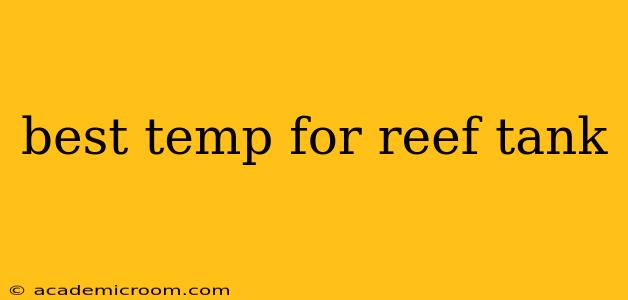Maintaining the ideal temperature for your reef tank is paramount to the health and survival of your corals, fish, and invertebrates. While a specific number might seem simple, the reality is a bit more nuanced. This guide will delve into the optimal temperature range, the factors affecting temperature stability, and troubleshooting common temperature-related issues. Let's dive in!
What is the ideal temperature for a reef tank?
The generally accepted ideal temperature range for a reef tank is 76-82°F (24-28°C). This range mimics the natural temperature fluctuations found in many coral reef ecosystems. However, it's crucial to understand that consistency is just as important as the temperature itself. Sudden or drastic temperature swings can be incredibly stressful and even lethal to your tank inhabitants. Aim for a stable temperature within this range, avoiding fluctuations of more than a couple of degrees.
Why is maintaining a stable temperature so crucial?
Maintaining a stable temperature is crucial for several reasons:
-
Coral Health: Corals are highly sensitive to temperature changes. Even small fluctuations can lead to bleaching, disease, and ultimately, death. A stable temperature promotes optimal growth and vibrant coloration.
-
Invertebrate Health: Many invertebrates, such as crustaceans and mollusks, are also sensitive to temperature changes. Extreme temperatures can compromise their immune systems, making them more susceptible to disease.
-
Fish Health: While fish are generally more tolerant of temperature fluctuations than corals and invertebrates, consistent temperatures prevent stress and promote their overall health and well-being.
-
Biological Processes: The biological processes within your reef tank, including nitrification and denitrification, are temperature-dependent. Maintaining a stable temperature ensures these crucial processes function optimally.
How can I maintain a stable temperature in my reef tank?
Maintaining a stable temperature requires a multi-pronged approach:
-
High-Quality Heater: Invest in a reliable and accurate submersible heater specifically designed for aquariums. Choose a heater with the appropriate wattage for your tank size.
-
Thermometer: Use a reliable thermometer—preferably two, placed in different locations within the tank—to monitor the temperature accurately. Consider both digital and analog thermometers for redundancy.
-
Proper Tank Placement: Avoid placing your tank in direct sunlight or near heat sources such as radiators or fireplaces, as these can cause unpredictable temperature fluctuations.
-
Regular Maintenance: Regularly clean your heater and ensure it's properly functioning. A malfunctioning heater can lead to drastic temperature changes.
-
Cooling System (in warmer climates): In warmer climates, consider adding a chiller or fan to help regulate the temperature, especially during summer months.
What are the signs of an improperly maintained temperature?
Several signs might indicate that your reef tank's temperature isn't ideal:
-
Coral Bleaching: This is a major warning sign. Bleached corals are pale and appear stressed.
-
Lethargic or Unresponsive Inhabitants: If your fish or invertebrates seem sluggish or unresponsive, temperature could be a contributing factor.
-
Algae Blooms: Unusual algae growth could indicate a temperature imbalance affecting the overall tank ecosystem.
-
Fish or Invertebrate Mortality: The death of any inhabitants is a serious sign that something is wrong, and temperature should be investigated.
How do temperature fluctuations affect my reef tank ecosystem?
Temperature fluctuations disrupt the delicate balance of your reef tank ecosystem. They can stress your organisms, making them more susceptible to disease and impacting their reproductive capabilities. Severe fluctuations can lead to mass mortality events.
What should I do if my reef tank temperature is too high or too low?
If the temperature deviates significantly from the ideal range, take immediate action:
-
Too High: Turn off any additional heating sources, use a fan to cool the water surface, or add ice (carefully and slowly!) to the water. If the problem persists, investigate your heater or consider a cooling system.
-
Too Low: Check your heater's functionality. If necessary, increase the heater's setting or add a supplementary heater.
Maintaining the best temperature for your reef tank is an ongoing process. By understanding the ideal range, the importance of stability, and the potential consequences of fluctuations, you can create a thriving environment for your marine life. Remember, consistent monitoring and prompt action are key to success!
